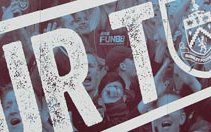Just in case you were not around in 1882, Richard Moore talks a load of old Bull (Hotel) and reminds Clarets fans how it all began.
Just in case you were not around in 1882, Richard Moore talks a load of old Bull (Hotel) and reminds Clarets fans how it all began……
Burnley Bull
On the evening of the 18th of May 1882 at the Bull Hotel in the centre of Burnley, a special committee meeting of a local rugby team called Burnley Rovers had been called.
The Bull(pictured above) was a fine establishment, its façade lit by “Old Gawmless” the lamp in the centre of the street outside, some say because of its “dim” performance, others because it was standing in the middle of the road.
They could have chosen to meet in almost anyone of the nearly 200 inns, hotels, taverns and beerhouses that had grown up in the town despite the efforts of the Temperance Movement but they chose ‘The Bull’ because it was the town`s leading hotel, known for its “magnificence” even though it was nick-named “The Folly” by locals because of its ambitious 40 bedrooms.
Some of the committee members would have arrived on one of the new fangled steam trams introduced into the town the previous year, hissing and clanging along cobbled streets described as, “the most heavily bill posted in the country,” passing Thomas Hoghton`s grocers shop who advertised on his paper bags that, “Trams pass the door every 15 minutes.”
There`s entrepreneurship for you but he still hedged his traditional bets by having, on the same bag, a picture of an elegant couple arriving at his shop in an open hansom cab.
One or two of the committee might have been late, as there had been a bit of a dispute about the use of steam on certain streets and the new trams had to be pulled by horses for some of the way. If a member had walked from nearby Stoneyholme he`d have passed under the shadow of a giant, three tier gasholder, only the second to be built in England.
Others, perhaps chose to arrive by horse drawn Cab, oil lamps winking in the fading light.
With the meeting called to order, the evening`s business began.
“It hasn`t been a bad season,” the Rover`s Treasurer told them,” And were it not for our changing facilities being blown down and the access bridge to the ground being washed away, the balance sheet might have presented a different aspect.”
This was applauded and the balance sheet adopted unanimously. Two penny or three penny cigars would have been puffed on, purchased from Joshua Duckworth`s a couple of doors away.
Then, under the yellow light of flickering gas mantles, committee member Mr. Ernest Bradshaw stood up, cleared his throat and spoke,
” I move that the rugby club, in future, play under Association Football rules.”
Without more ado, for I suspect Burnley folk had acquired a reputation for bluntness even then, the motion was passed and a celebratory round of Grimshaw`s Ale was probably ordered.
A few days later it was decided, in order to forestall anyone else having the idea, to change the name of the new club to “Burnley Football Club”.
The club would play its first match at Turf Moor, still its ground in 2010, on Saturday, 17th of February 1883.
A proud day except that their opponents, neighboring Rawtenstall, ran off winners, beating Burnley Football Club, 6-3.
The first result might have been disappointing but if there was ever any sunshine to be had under the town`s sulphuric, rain soaked skies, the Club`s committee was determined to find it.
In 1888 Burnley Football Club proudly became one of the founder members of the Football League, along with, Accrington, Aston Villa, Blackburn, Bolton, Derby, Everton, Notts. County, Preston, Stoke City, West Bromwich Albion and Wolverhampton Wanderers.
Burnley. Cotton. Football.
The last two words would come to define the town, sometimes to its annoyance, for years to come.
Richard Moore



Would love a Tardis for Christmas so I could go back to those days. The thought of Rawtenstall (who I think eventually became Rossendale United) beating the Clarets made me chuckle. Had I been born in Waterfoot back in Victorian times, I could welll have been a Rawtenstall supporter!!
Phil this is brilliant, I love reading stuff like this and have read the article twice over. For me it says who we are and why we are, long may you continue putting stuff like this up for us to read.
Thanks VR we try our best. Richard though is the one that needs to take all the plaudits for this one
Four questions! On what streets was the Bull on? Who decided on the name Turf Moor? Is that what the area was called before the club took it over? What used to be there?
Hell Fire Couch you don’t want much….lol just about to set off on route to the A1…. will post a scores thing around 1am for your delight tomorrow!
VR – I don’t know the answers. I am just interested to see if anyone else does, as I would love to know.
Another splendid Article Richard, CP I am able to answer one of your questions, the Bull hotel building still stands it is now occupied by Burtons men’s clothing and is at the bottom of Manchester Road
There is also a replica of the old Gawmless now standing their
Does the word ‘turf’ in Turf Moor mean that this bit of moorland got covered in turves of grass fit for footy to be played on? Or does it mean that folk used to go out to that nearby bit of moorland to cut turves of peat for their fires? Or something else?
i think that grimshaw ale sounds the bllks,,,,,,i want a pint,,,